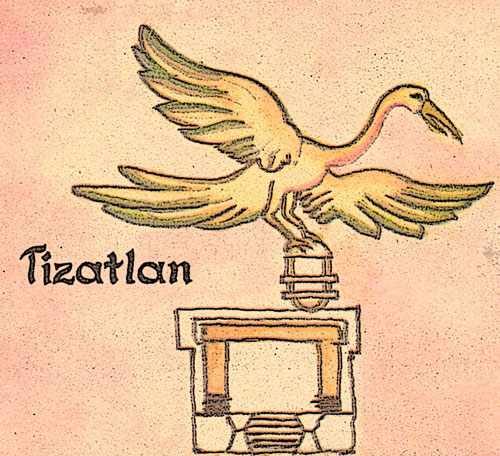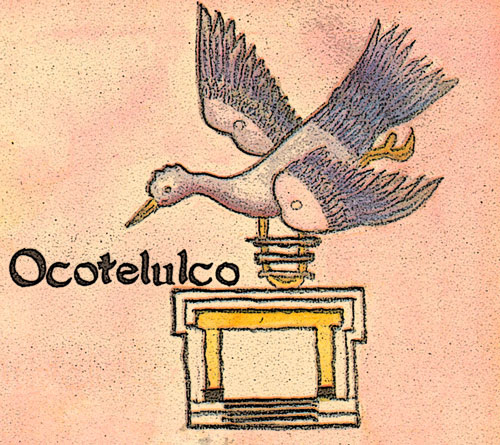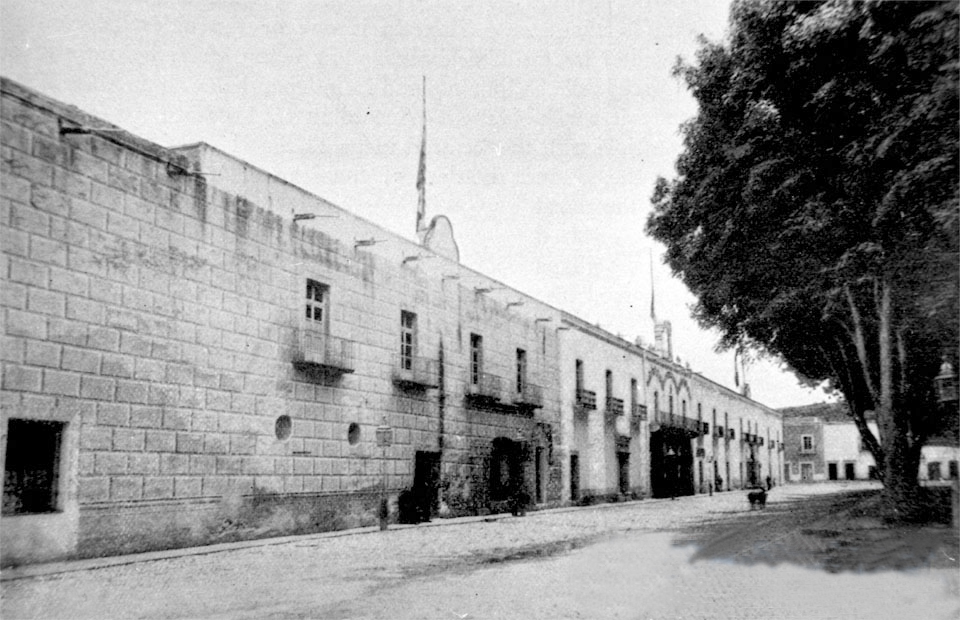|
Tizatlan
Tizatlan, in pre-Columbian Mexico, was one of the four independent altepemeh (polities, sing. altepetl) that constituted the confederation of Tlaxcallan. Today Tizatlan is a part of the modern city of Tlaxcala, and the Pre-Columbian city is visible as a small archaeological site. The site is in the state of Tlaxcala in central Mexico. History Tizatlan was the third of the four altepemeh to be founded, but at the time of the Spanish conquest of Mexico it was, along with Ocotelolco, the most powerful of the four allied communities. Where Ocotelolco held the economical power, having the main market in the region, Tizatlan had the military power and commanded the Tlaxcallan armies. When the Spanish arrived in Mexico Tizatlan was ruled by the aging Xicotencatl I "the Elder" aided by his son the military leader Xicotencatl II Xicotencatl II Axayacatl, also known as Xicotencatl the Younger (died 1521), was a prince and warleader, probably with the title of ''Tlacochcalcatl'', of th ... [...More Info...] [...Related Items...] OR: [Wikipedia] [Google] [Baidu] |
Tlaxcala (Nahua State)
Tlaxcala ( 'place of maize tortillas') was a pre-Columbian city and state in central Mexico. During the Spanish conquest of the Aztec Empire, Tlaxcala allied with the Spanish Empire against the Aztecs, supplying a large contingent for and sometimes most of the Spanish-led army that eventually destroyed the Aztec Empire. History The Tlaxcalans arrived in Central Mexico during the Late Postclassic. They first settled near Texcoco in the valley of Mexico, between the settlement of Cohuatlinchan and the shore of Lake Texcoco. After some years the Tlaxcallans were driven out of the valley of Mexico and moved to the east, splitting into three groups along the way. While one group continued north towards the modern state of Hidalgo and another remained in the vicinity of Texcoco, a third group arrived in the modern valley of Tlaxcala, where they established the city of Tepetícpac Texcallan under the leadership of Culhuatecuhtli Quanex. Over the subsequent years, the Tlaxcallan ... [...More Info...] [...Related Items...] OR: [Wikipedia] [Google] [Baidu] |
Ocotelolco (Altepetl)
Ocotelolco (sometimes spelled Ocotelulco), in pre-Columbian Mexico, was one of the four independent altepetl (polities) that constituted the confederation of Tlaxcallan. The site is in the present day state of Tlaxcala in central Mexico. History Ocotelolco was the second of the four altepetl to be founded. At the time of the Spanish conquest of Mexico The Spanish conquest of the Aztec Empire, also known as the Conquest of Mexico or the Spanish-Aztec War (1519–21), was one of the primary events in the Spanish colonization of the Americas. There are multiple 16th-century narratives of the eve ... it was, along with Tizatlan, the most powerful of the four allied communities. Where Ocotelolco held the economical power, having the main market in the region, Tizatlan had the military power and commanded the Tlaxcallan armies. When the Spanish arrived in Mexico Ocotelolco was ruled by Maxixcatzin. Through a series of political events Ocotelolco finally achieved dominance over T ... [...More Info...] [...Related Items...] OR: [Wikipedia] [Google] [Baidu] |
Xicotencatl I
Xicotencatl I or Xicotencatl the Elder (c. 11 House (1425) – c. 4 Rabbit (1522)) was a long-lived ''tlatoani'' (king) of Tizatlan, a Nahua ''altepetl'' within the pre-Columbian confederacy of Tlaxcala, in what is now Mexico. Etymology His Nahuatl name, pronounced , is sometimes spelled Xicohtencatl. In 1519 he was baptized as Lorenzo Xicotencatl or Don Lorenzo de Vargas. Biography At the time of the Spanish conquest of the Aztec Empire he was very old and of poor health. He was instrumental in aligning the Tlaxcala with Hernán Cortés' Spaniards.Diaz, B., 1963, The Conquest of New Spain, London: Penguin Books, Tlaxcalan historian Diego Muñoz Camargo wrote of him that he was more than 120 years old and that he could only see Cortés if he had someone lift his eyelids for him. He also writes that he had more than 500 wives and concubines and consequently a large number of children, including Xicotencatl II and the wife of Jorge de Alvarado - Doña Lucía. His great ... [...More Info...] [...Related Items...] OR: [Wikipedia] [Google] [Baidu] |
Xicotencatl II
Xicotencatl II Axayacatl, also known as Xicotencatl the Younger (died 1521), was a prince and warleader, probably with the title of ''Tlacochcalcatl'', of the pre-Columbian state of Tlaxcala (Nahua state), Tlaxcallan at the time of the Spanish conquest of the Aztec Empire. Biography He was the son of the ruler of Tizatlan (Altepetl), Tizatlan, one of the four confederate altepetl, altepeme of the Tlaxcallan state, of which Xicotencatl the Younger was considered to be the ''de facto'' ruler because of his father's weakened health. His Nahuatl name, pronounced , is sometimes also spelled Xīcohtēncatl and means "person from Xīcohtēnco," a place name that can be translated "at the edge of the bumblebees." He is known primarily as the leader of the force that was dispatched from Tlaxcallan to intercept the forces of Hernán Cortés and his Totonac allies as they entered Tlaxcallan territory when going inland from the Veracruz coast.Diaz, B., 1963, The Conquest of New Spain, Lond ... [...More Info...] [...Related Items...] OR: [Wikipedia] [Google] [Baidu] |
Tlaxcala
Tlaxcala (; , ; from nah, Tlaxcallān ), officially the Free and Sovereign State of Tlaxcala ( es, Estado Libre y Soberano de Tlaxcala), is one of the 32 states which comprise the Federal Entities of Mexico. It is divided into 60 municipalities and the capital city is Tlaxcala City. It is located in East-Central Mexico, in the altiplano region, with the eastern portion dominated by the Sierra Madre Oriental. It is bordered by the states of Puebla to the north, east and south, México to the west and Hidalgo to the northwest. It is the smallest state of the republic, accounting for only 0.2% of the country's territory. The state is named after its capital, Tlaxcala, which was also the name of the Pre-Columbian city and culture. The Tlaxcalans allied themselves with the Spanish to defeat the Aztecs, with concessions from the Spanish that allowed the territory to remain mostly intact throughout 300 years of colonial period. After Mexican Independence, Tlaxcala was declared a f ... [...More Info...] [...Related Items...] OR: [Wikipedia] [Google] [Baidu] |
Tlaxcala, Tlaxcala
Tlaxcala, officially Tlaxcala de Xicohténcatl (), is the capital city of the Mexican state of Tlaxcala and seat of the municipality of the same name. The city did not exist during the pre-Hispanic period but was laid out by the Spanish as a center of evangelization and governance after the Spanish conquest of the Aztec Empire. The city was designated as a diocese but eventually lost that status to Puebla as its population declined. The city still has many of its old colonial structures, including the former Franciscan monastery, and newer civic structures like the Xicohtencatl Theatre. History The name Tlaxcala most likely comes from a Nahuatl phrase which means “place of corn bread.” The Aztec glyph for the Mesoamerican dominion is two hills from which emerge a pair of hands making a tortilla. The site of the modern city did not have a settlement for most of the pre Hispanic era. The area was ruled by a coalition of four dominions called Tepeticpac, Ocotelolco, Tizatlan a ... [...More Info...] [...Related Items...] OR: [Wikipedia] [Google] [Baidu] |
Altepetl
The (, plural ''altepeme'' or ''altepemeh'') was the local, ethnically-based political entity, usually translated into English as "city-state," of pre-Columbian Nahuatl-speaking societiesSmith 1997 p. 37 in the Americas. The ''altepetl'' was constituted of smaller units known as ''calpolli'' and was typically led by a single dynastic ruler known as a ''tlatoani'', although examples of shared rule between up to five rulers are known. Each ''altepetl'' had its own jurisdiction, origin story, and served as the center of Indigenous identity. Residents referred to themselves by the name of their ''altepetl'' rather than, for instance, as "Mexicas." "''Altepetl''" was a polyvalent term rooting the social and political order in the creative powers of a ''sacred mountain'' that contained the ancestors, seeds and life-giving forces of the community. The word is a combination of the Nahuatl words (meaning "water") and (meaning "mountain"). A characteristic Nahua mode was to imagine the ... [...More Info...] [...Related Items...] OR: [Wikipedia] [Google] [Baidu] |
Pre-Columbian
In the history of the Americas, the pre-Columbian era spans from the original settlement of North and South America in the Upper Paleolithic period through European colonization, which began with Christopher Columbus's voyage of 1492. Usually, the era covers the history of Indigenous cultures until significant influence by Europeans. This may have occurred decades or even centuries after Columbus for certain cultures. Many pre-Columbian civilizations were marked by permanent settlements, cities, agriculture, civic and monumental architecture, major earthworks, and complex societal hierarchies. Some of these civilizations had long faded by the time of the first permanent European colonies (c. late 16th–early 17th centuries), and are known only through archaeological investigations and oral history. Other civilizations were contemporary with the colonial period and were described in European historical accounts of the time. A few, such as the Maya civilization, had their own wri ... [...More Info...] [...Related Items...] OR: [Wikipedia] [Google] [Baidu] |
Mexico
Mexico (Spanish: México), officially the United Mexican States, is a country in the southern portion of North America. It is bordered to the north by the United States; to the south and west by the Pacific Ocean; to the southeast by Guatemala, Belize, and the Caribbean Sea; and to the east by the Gulf of Mexico. Mexico covers ,Mexico ''''. . making it the world's 13th-largest country by are ... [...More Info...] [...Related Items...] OR: [Wikipedia] [Google] [Baidu] |
Spanish Conquest Of Mexico
The Spanish conquest of the Aztec Empire, also known as the Conquest of Mexico or the Spanish-Aztec War (1519–21), was one of the primary events in the Spanish colonization of the Americas. There are multiple 16th-century narratives of the events by Spanish conquistadors, their indigenous allies, and the defeated Aztecs. It was not solely a contest between a small contingent of Spaniards defeating the Aztec Empire but rather the creation of a coalition of Spanish invaders with tributaries to the Aztecs, and most especially the Aztecs' indigenous enemies and rivals. They combined forces to defeat the Mexica of Tenochtitlan over a two-year period. For the Spanish, the expedition to Mexico was part of a project of Spanish colonization of the New World after twenty-five years of permanent Spanish settlement and further exploration in the Caribbean. Significant events in the conquest of Mesoamerica Historical sources for the conquest of Mexico recount some of the same events in both ... [...More Info...] [...Related Items...] OR: [Wikipedia] [Google] [Baidu] |
Alfredo Chavero
Alfredo Chavero (1841–1906) was a Mexican archaeologist, politician, poet, and dramatist. According to Howard F. Cline, "Chavero's most enduring claim to remembrance rests...on iscompletion and extension of Ramírez's plans to republish major native histories and his editorship of pictorial documents." Research Chavero conducted numerous investigations on Mexican antiquities. He published ''Historia Antigua de Mexico'', as well as several works on Aztec archaeology, especially on ancient monuments. While excavating the pyramids of Cholula, he discovered some idols that are now in the National Museum of Mexico. His books are often referred to because of his research on Father Sahagún and to the Sun Stone. . Political career Chavero became a member of the Mexican Congress in 1869. He supported the Mexican presidents Benito Juárez, Sebastián Lerdo de Tejada, Manuel González, and Porfirio Díaz in succession, notwithstanding their different policies. On 25 June 1879 ... [...More Info...] [...Related Items...] OR: [Wikipedia] [Google] [Baidu] |





